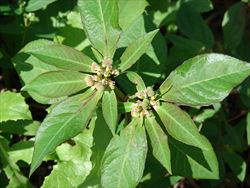- Worldwide distribution. In Australia, and most Pacific island countries.
- Aggressive, annual weed, of major economic and environmental importance. Grows rapidly, produces abundant seed during short life cycle. Forms dense canopies over crop plants – cocoa, coffee, cotton, maize, papaya, sugarcane, tea, rice.
- Stems erect, up to 60 cm, hollow, reddish-green, smooth, sparsely branched, with latex. Lower leaves alternate, upper opposite, up to 12cm long and 7cm wide, pointed tips and leaf stalks 1-4cm – shorter on upper leaves. Upper leaves with pale patches at base. Cup-shaped structurers (formed from leaf-like bracts) at top of stems each containing several male flowers, and a single female flower producing three seeds. No petals or sepals. Funnel-like opening - the gland.
- Spread: seed in water, mud on machinery/vehicles, livestock. Possibly, collected for ornamental and medicinal. use.
- Biosecurity: risk is unofficial introduction of seed and plants. Check imported machinery/vehicles and livestock.
- Biocontrol: none.
- Cultural control: hand-weed; slashing; mulch (5-10cm) to prevent seedling growth; clean soil and seeds from machinery/vehicles.
- Chemical control: In Australia, fluroxypyr, imazapic, amicarbazone, pendimethalin, glyphosate. In Fiji, glyphosate, 2,4-D, diuron.
Pacific Pests, Pathogens and Weeds - Online edition
Pacific Pests, Pathogens, Weeds & Pesticides
Milkweed (516)
Milkweed. It is also known as wild poinsettia, fireplant, Mexican fireplant, painted spurge, and more.
Euphorbia heterophylla; previously, known as Euphobia geniculata, Poinsettia heterophylla. It is a member of the Euphorbiaceae. Sub-species are recognised by some taxonomists.
AUTHORS Grahame Jackson & Makereta Ranadi
Information from Euphorbia heterophylla L., Euphorbiaceae. Pacific island ecosystems at risk. (PIER). (http://www.hear.org/pier/species/euphorbia_heterophylla.htm); and Euphorbia heterophylla L. Weeds of Australia. Biosecurity Queensland Edition. Queensland Government. (https://keyserver.lucidcentral.org/weeds/data/media/Html/euphorbia_heterophylla.htm); and Euphorbia heterophylla L. Plants of the world online. Royal Botanic Gardens, Kew. (https://powo.science.kew.org/taxon/urn:lsid:ipni.org:names:30062970-2); and CABI Euphorbia heterophylla (wild poinsettia) (2021) Crop Protection Compendium (https://www.cabi.org/cpc/datasheet/23313); and from Fern K (2021) Euphorbia heterophylla L. Euphorbiaceae. Tropical Plants Database. (http://tropical.theferns.info/viewtropical.php?id=Euphorbia+heterophylla). Photo 1 Euphorbia heterphylla. International Institute of Tropical Agriculture. (https://www.flickr.com/photos/iita-media-library/6220269932/in/photolist-atEvxj-2iidTwE-2j8TEyJ-2iiggbW-2iidU2C-2iidTAs-2iihqZC-2iiggss-2iihqFm-2iihqHA-2kYhtza-Ds5mMF-bMhGck-2k5H6mM-DUu3TX-DXLfHy-EercD1-2jSJNyS-RYG37A-2e6hdh6-2cZew39-DSamAS-E1ytEM-2hLwqwN-ftsw17-EpTowe-6TJaDF-DxBzJB-aBAjfo-2mSM9wS-D6bF8h-2mSQqFx-2hLAcHN-DUEkYV-HJyeab-EerbPf-2kYKT7p-cur5MC-25NDmRL-GUh2dz-bor52-FHYyW4-GDmpvF-o8CFbr-cZGkKo-bgsWvi-5BvG4y-9Aqd8N-akpfC7-nRrE54/). Photo 2 Forest and Kim Starr. Starr Environmental. Euphorbia heterophylla (Green leaved wild poinsettia). (http://www.starrenvironmental.com/images/search/?q=070111-3293). Photo 3 Wild poinsettia (Euphorbia heterophylla). Rebekah D. Wallace, University of Georgia, Bugwood.org.
Produced with support from the Australian Centre for International Agricultural Research under project HORT/2016/185: Responding to emerging pest and disease threats to horticulture in the Pacific islands, implemented by the University of Queensland, in association with the Pacific Community and Koronivia Research Station, Ministry of Agriculture, Fiji.





